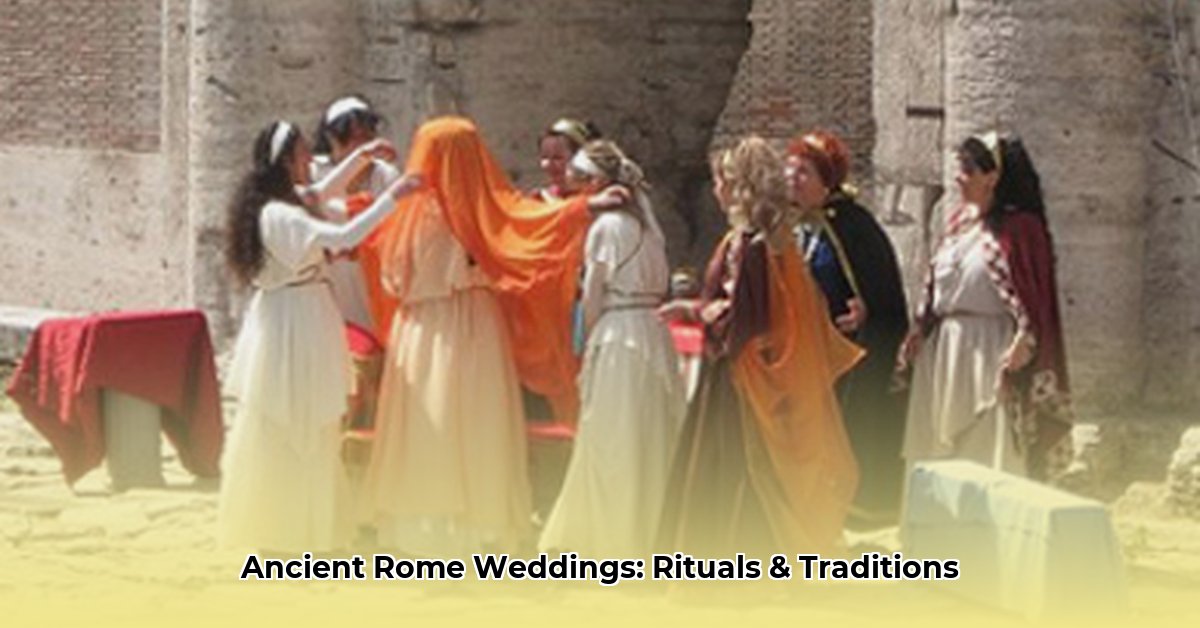Step into the intricate world of ancient Roman matrimony, an elaborate tapestry woven with threads of legal obligation, sacred religious rites, and profound social structures. Far from being mere declarations of love, these unions were meticulously crafted alliances designed to forge robust family connections, bolster societal status, and ensure dynastic continuity. Delving beyond common cinematic portrayals, we uncover the true essence of these ceremonies, steeped in tradition and deeply rooted within Roman culture. You can discover more about Roman artifacts online.
The Foundations of Roman Marriage: A Pragmatic Union
Marriage in ancient Rome was primarily a calculated decision, particularly among the elite. Considerations like wealth, political influence, and the continuation of the family lineage were paramount, often overshadowing personal affection. Diverse forms of marriage accommodated various social classes and requirements:
- Usus: The simplest form, requiring a couple to live together consistently for one year. If the wife absented herself for three consecutive nights, she remained legally independent.
- Coemptio: A more binding union, involving a symbolic “purchase” of the bride by her husband, signifying her transfer into his legal authority. This was a form of “sale” into manus.
- Confarreatio: The strictest and most ancient form, reserved for patricians and essential for certain high priests like the Flamen Dialis. It involved a complex religious ceremony and resulted in the wife’s complete absorption into her husband’s family, placing her entirely under his manus (legal control).
The concept of manus (Latin for “hand” or “control”) was central, determining a woman’s legal authority after marriage. In cum manu marriages, she left her birth family’s control to enter her husband’s, becoming akin to his property. Conversely, sine manu marriages allowed the wife to remain under her birth family’s authority, granting her greater independence.
Legally recognized matrimonium was between citizens or those with conubium (the right to intermarry), carrying specific rights and obligations. Contubernium, on the other hand, referred to partnerships, typically between slaves or a slave and a free person, lacking legal recognition. Minimum marital ages were generally 14 for males and 12 for females, though societal factors could influence exceptions.
Financial considerations were also pivotal. Dowries, substantial sums or property provided by the bride’s family, were transferred to the groom upon marriage. These assets reflected a family’s wealth and strategic positioning, solidifying economic and political advantages through the marital alliance.
The Sacred Ceremony: Symbolism in Every Gesture
Ancient Roman wedding ceremonies were rich with symbolism, designed to invoke divine favor and protect the union. Prior to the wedding day, an auspex (an interpreter of omens) would be consulted to ensure propitious signs, as inauspicious omens were believed to foreshadow misfortune. Certain dates were strictly avoided, notably the Kalends, Nones, and Ides of each month, the days following them, all of May and the first half of June (due to religious ceremonies), and the dies parentales (February 13-21).
The Bride’s Attire: A Shield of Tradition
The bridal outfit was meticulously crafted with protective and symbolic elements:
- Tunica Recta: A plain white woollen tunic, woven in one piece, was worn the night before and on the wedding day. This garment was said to be woven by the bride herself, showcasing her skill, and symbolized purity and tradition.
- Cingulum/Zona: A woollen belt tied around the tunica recta with a distinctive Hercules knot (nodus Herculaneus). This knot, believed to ward off evil and ensure fertility (like Hercules, who had many children), was uniquely untied by the groom on the wedding night, symbolizing the consummation of the marriage. It was also linked to Juno Cinxia, the goddess of girdles and untying.
- Flammeum: A flame-colored (often orange-yellow or red) veil that covered the bride’s head. Ancient authors considered it very old and highly auspicious, symbolizing faithfulness, fertility, and potentially shielding the bride’s blushes. Its use by the Flaminica Dialis (high priestess of Jupiter) lent it further religious significance, perhaps offering protection against divorce or misfortune. The veil was typically drawn back to reveal the face in art, but literary evidence suggests it could be pulled forward, at least partially.
- Sex Crines: A distinctive bridal hairstyle consisting of six intricate braids, parted with a celibate spear (hasta caelibaris). This spear, possibly a symbolic remnant of ancient marriage by capture, also implied the husband’s authority. Its use was deeply symbolic, potentially representing strength, fertility, or the indissolubility of the marriage (“with steel alone can their marriage be dissolved”). The sex crines may have been associated with Vestal Virgins, representing purity and a transitional state.
- Corolla: A crown or wreath made of fresh herbs, flowers (like marjoram), and foliage, often handpicked by the bride, symbolizing natural beauty and good fortune.
- Vittae: Woolen bands or fillets that hung from the sides of the infula (a red and white band-like crown) or secured the hair. These were widely seen as symbols of chastity and purity, with prostitutes notably forbidden to wear them.
- Saffron-colored shoes: Completing the ensemble, these shoes added a touch of vibrant color.
The Nuptial Ceremony: A Public Declaration
The ceremony itself typically took place at the bride’s father’s house, adorned with flowers and woollen bands. After favorable omens were confirmed, the bride and groom appeared in the atrium.
- Dextrarum Iunctio: The pivotal “joining of right hands” was performed by the pronuba, a matron who had been married only once and whose husband was still living. This ritual, deeply symbolic, signified their union, shared commitment, and mutual fidelity. The right hand was consecrated to Fides, the goddess of fidelity, making the clasp a solemn pledge.
- Vows: The bride often spoke the ancient formula: “Quando tu Gaius, ego Gaia” (“Where you are Gaius, I am Gaia”), signifying her full integration into her husband’s life and household.
- Sacrifices: Offerings were made to deities, especially Juno, the goddess of marriage and childbirth, and Hymen, the god of wedding ceremonies. In confarreatio, a spelt cake (farreum libum) was offered to Jupiter and consumed by the couple, followed by prayers to Juno, Tellus (Earth), Picumnus, and Pilumnus (country deities).
- Marriage Contract: A public declaration of the marriage contract, often recorded on a tablet, formally acknowledged the union before witnesses (typically ten for confarreatio).
- Wedding Feast (Cena Nuptialis): An elaborate banquet followed, usually at the bride’s home, concluding with the distribution of wedding cake (mustaceum), nuts (symbols of fertility), and the singing of bawdy, unchaste versus Fescennini to ward off the evil eye.
The Nuptial Procession: A Journey to a New Life
As evening approached, the domum deductio (leading home the bride) commenced, a vibrant and essential public procession. It was sometimes described with language emphasizing the bride’s purported fear, suffering, and reluctance (pudor), a possible artistic conceit reflecting a feigned resistance to sex or the emotional upheaval of leaving her family.
- Escorts and Torches: The procession was led by flute-players and five torch-bearers. The bride was attended by three patrimi et matrimi (boys whose parents were both still living), two holding her arms, and the third carrying the wedding torch of whitethorn (spina alba), a lucky material.
- Emblems of Domesticity: The bride carried a distaff and spindle, symbolic of her future role as mistress of the household and her expected industry in weaving.
- Shouts and Offerings: The crowd shouted “Talassio,” an ancient wedding cry whose original meaning was lost even to the Romans, and threw nuts, symbolizing fertility. The bride made offerings of coins to the Lares Compitales (gods of the crossroads) and exchanged one with her groom as an emblem of her dowry, also offering one to his household Lares upon arrival.
- Arrival at New Home: Upon reaching the groom’s house, the bride anointed the doorposts with oil and fat (emblems of plenty) and wound them with woollen bands, symbolizing her new domestic duties. She was then traditionally lifted carefully over the threshold by two male attendants (or slaves in earlier times) to prevent her from tripping, which was a dire omen. This ritual was also tied to the myth of the Rape of the Sabine Women, symbolizing a bride’s reluctance to leave her father’s home.
- Entering the Home: Once inside, the bride touched fire and water, symbolizing her integration into the new household and purification. She then offered a coin to her husband and received the keys to the house, formally becoming its mistress.
- Lectus Genialis: The pronuba would then lead the bride to the lectus genialis, the nuptial couch, which remained a piece of ceremonial furniture in the atrium.
- Repotia: On the next day, a second wedding feast (repotia) was held in the new home, where the bride made her first offering to the gods as a matrona (married woman).
Divine Endorsement: Gods and Matrimony
Religion played an indispensable role in ancient Roman weddings, with numerous deities invoked to bless the union:
- Juno: The primary goddess of marriage, childbirth, and women, often invoked as Juno Pronuba (the goddess who oversees the wedding) and Juno Cinxia (goddess of untying the belt).
- Hymen: The god of wedding ceremonies and nuptial songs, whose presence ensured a joyous and prosperous union.
- Janus: The god of beginnings, transitions, and thresholds, invoked at the start of the ceremony.
- Jupiter: The father god, often receiving sacrifices during the confarreatio.
- Tellus: The Earth goddess, associated with fertility.
- Lares: Household spirits and guardian deities, to whom offerings were made for protection and prosperity. Girls dedicated their childhood toys and bulla (amulets) to these deities or to Fortuna Virginalis before marriage.
The transition from her birth family’s sacra privata (private religious practices) to those of her husband’s family underscored the profound shift in her religious and familial allegiances.
Divorce in Rome: A Striking Contrast
Compared to many other ancient civilizations, divorce in Rome was surprisingly accessible and relatively straightforward, reflecting a pragmatic societal view of marriage as a contract.
- Ease of Dissolution: Roman marriage was based on mutual consent (affectio maritalis), and similarly, divorce required only a declaration of intent from either spouse, or both, often before seven witnesses. There was no complex legal process or judicial decree required.
- Reasons for Divorce: Infidelity, barrenness, or the desire for a more advantageous marriage were common grounds. Men generally had an easier time initiating divorce, but women also held the right to separate, especially in sine manu marriages.
- Dowry Return: A primary economic concern was the return of the dowry to the wife or her family upon dissolution, though this could sometimes lead to disputes.
- Social Implications: While not as stigmatized as in some other cultures, divorce could still carry social repercussions, particularly for women who initiated it without compelling reason. Repeated divorces could also damage a man’s reputation.
- Imperial and Christian Influence: Emperors like Augustus attempted to regulate divorce with laws like the lex Julia, aiming to boost population and strengthen traditional family values, though these efforts often introduced new complexities. As Christianity gained prominence, its ideal of marriage as an indissoluble bond starkly contrasted with Roman legal practices, leading to centuries of evolving legal and social landscapes.
Roman divorce evolved alongside changing social norms, legal frameworks, and religious shifts, reflecting a dynamic institution rather than a static one.
Enduring Legacies: From Antiquity to Modernity
It is remarkable how many elements of ancient Roman weddings persist in modern traditions, illustrating their profound and lasting influence on Western culture.
| Ancient Roman Wedding Element | Modern Wedding Equivalent | Significance |
|---|---|---|
| Tunica Recta (simple white dress) | White wedding gown | Symbol of purity and tradition. |
| Flammeum (orange-colored veil) | Bride’s veil | Protection from evil, modesty, and mystery. |
| Dextrarum Iunctio (joining hands) | Exchanging vows, rings, and joining hands | Mutual commitment and fidelity. |
| Carrying bride over the threshold | A widely practiced custom today (by groom) | Protection against bad omens; symbolic “abduction” |
| Scattering nuts | Throwing rice or confetti/petals | Wishing fertility and prosperity. |
| Nodus Herculaneus (Hercules Knot) | The phrase “tying the knot” | Symbolic bond, fertility, and marital strength. |
| Engagement Rings (iron, gold, diamond) | Engagement rings (often diamond) | Promise of marriage, commitment (via vena amoris). |
| June as a popular wedding month | June weddings | Named after Juno, goddess of marriage. |
| Bawdy songs & revelry | Toasts, speeches, and celebratory atmosphere | Averting evil, promoting joy. |
From the deep superstitions guiding auspicious dates to the profound legal and societal implications of each union, ancient Roman weddings were far from simple. They were grand spectacles, strategically designed to cultivate alliances, safeguard family legacies, and ensure enduring prosperity. The echoes of these ancient practices resonate even today, reminding us of the enduring power of tradition across millennia.










